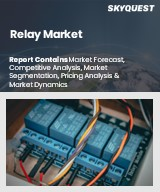
|
시장보고서
상품코드
1806379
전기기계식 릴레이 시장 : 제품 유형별, 동작 원리별, 기능별, 접점 구성별, 장착 유형별, 최종사용자별, 유통 채널별 - 세계 예측(2025-2030년)Electromechanical Relay Market by Product, Working Principle, Function, Contact Configuration, Mounting Type, End User, Distribution Channel - Global Forecast 2025-2030 |
||||||
전기기계식 릴레이 시장의 2024년 시장 규모는 65억 8,000만 달러로 평가되었으며, 2025년에는 CAGR 6.69%로 70억 달러로 성장하여 2030년에는 97억 1,000만 달러에 달할 것으로 예측됩니다.
| 주요 시장 통계 | |
|---|---|
| 기준 연도 2024년 | 65억 8,000만 달러 |
| 추정 연도 2025년 | 70억 달러 |
| 예측 연도 2030년 | 97억 1,000만 달러 |
| CAGR(%) | 6.69% |
전기기계식 릴레이 산업의 새로운 시장 역학을 이해하기 위한 종합적인 소개서 작성
전기기계식 릴레이는 많은 전기 응용 분야에서 기본 구성요소이며, 전력 회로를 제어하기 위해 전자기 원리를 채택한 필수적인 스위치 역할을 합니다. 대형 전력 회로에서 제어 신호를 분리하는 기능은 복잡한 시스템에서 비교할 수 없는 안전성과 신뢰성을 제공합니다. 자동차 전자, 산업 자동화, 에너지 분배, 가전제품 등 다양한 분야에서 이러한 장치는 중요한 업무를 지속적으로 지원하고 있습니다.
경쟁 구도를 재정의하는 변화의 검증 전기기계 계전기 분야의 기술 발전과 규제 환경의 변화
전기기계 계전기의 시장 환경은 급속한 기술 혁신과 진화하는 규제 프레임워크에 의해 변화하고 있습니다. 전 세계적인 스마트 그리드 현대화 노력으로 양방향 통신 및 원격 제어가 가능한 릴레이의 채택이 가속화되고 있으며, 유틸리티 기업이 그리드의 신뢰성을 높이고 분산형 에너지 자원을 보다 효과적으로 통합할 수 있도록 돕고 있습니다.
2025년 미국 관세가 공급망에 미치는 누적 영향 분석 전기기계식 계전기 제조 비용 및 전략적 조달
2025년 미국의 새로운 관세 시행으로 인해 전기기계식 릴레이 수입 업체와 국내 제조업체 모두에게 복잡한 비용 고려 사항이 도입되었습니다. 아시아 주요 제조 거점으로부터 조달되는 부품은 추가 관세에 직면하게 될 것이며, 공급망 전략을 재구축하고 구매자는 조달 결정을 재평가해야 할 것입니다.
다양한 제품 유형의 작동 원리와 최종사용자 용도가 전기기계식 릴레이 시장의 역학을 촉진하는 방법을 보여주는 주요 세분화 인사이트.
세분화 분석을 통해 다양한 제품 유형, 작동 원리 및 고객 요구 사항이 전기 기계식 계전기 시장의 역학을 어떻게 형성하는지 알 수 있습니다. 제품 분류에는 쌍안정 제어용으로 설계된 래칭 릴레이, 고속 스위칭과 낮은 신호 간섭을 자랑하는 리드 릴레이, 과전류 상태를 보호하는 열 릴레이, 정확한 시퀀스 기능을 제공하는 타임 딜레이 릴레이 등이 있습니다. 이러한 카테고리를 통해 제조업체는 개별 애플리케이션의 요구 사항에 따라 솔루션을 맞춤화할 수 있습니다.
아메리카, 유럽, 중동 및 아프리카, 아시아태평양의 시장 촉진요인과 성장 패턴이 산업의 궤도를 어떻게 형성할 것인지에 대한 주요 지역별 인사이트를 제시합니다.
전기기계식 계전기 산업의 지역적 역학은 아메리카, 유럽, 중동 및 아프리카, 아시아태평양별로 크게 다르며, 각 지역마다 고유한 성장 촉진요인과 도전과제를 제시하고 있습니다. 아메리카에서는 인프라 현대화 프로그램과 자동차 전동화 이니셔티브의 결합으로 고신뢰성과 진단 시스템과의 통합을 실현하는 릴레이에 대한 수요가 증가하고 있습니다. 국내 생산시설은 니어쇼어 생산 동향을 활용하여 관세의 영향을 줄이기 위해 확장하고 있습니다.
주요 기업의 전략 평가 세계 전기기계식 계전기 시장 상황을 선도하는 경쟁사 포지셔닝 및 혁신적 노력에 대한 평가
전기기계식 릴레이 시장의 주요 기업들은 기술 혁신, 전략적 파트너십, 세계 사업 확장에 대한 노력으로 두각을 나타내고 있습니다. 업계 선도 기업들은 센싱, 진단, 무선 통신 기능을 통합한 차세대 릴레이 아키텍처를 도입하기 위해 연구개발에 많은 투자를 해왔습니다. 이러한 노력을 통해 제품 성능 향상뿐만 아니라 원격 모니터링 및 예지보전 제공을 통해 서비스 기반의 새로운 수익원을 창출하고 있습니다.
전기기계 계전기 분야의 기술 혁신과 운영의 우수성을 활용하기 위해 업계 리더를 지원하는 실용적인 제안을 제공합니다.
전기기계식 계전기 분야에서 경쟁 우위를 확보하고자 하는 업계 리더는 기술 혁신, 공급망 강건성, 시장 확대를 결합한 다각적인 접근 방식을 우선시해야 합니다. 소형화 및 디지털 통합에 초점을 맞춘 연구개발에 투자함으로써, 예지보전 및 원격 설정에 대한 수요 증가에 대응하는 스마트 릴레이 솔루션을 창출할 수 있습니다.
데이터의 무결성을 보장하는 엄격한 조사 방법 개요 전기기계식 릴레이에 대한 인사이트를 위한 종합적인 1차 및 2차 조사, 그리고 견고한 검증 방법을 통해 데이터 무결성을 보장합니다.
이번 조사는 종합적인 조사 대상과 분석의 완전성을 보장하기 위해 엄격한 다단계 방식을 채택했습니다. 그 과정은 업계 잡지, 규제 문서, 특허 출원, 기업 정보 공개 등을 활용한 광범위한 2차 조사를 통해 기초 지식을 확립하는 것으로 시작되었습니다. 일반적으로 이용 가능한 거래 데이터와 기술 표준의 출처는 시장 촉진요인과 응용 요구 사항에 대한 추가적인 배경을 제공했습니다.
진화하는 전기기계식 계전기 산업에서 기회와 과제를 탐색하는 이해관계자들을 위한 전략적 하이라이트와 향후 전망 요약 자료.
분석을 종합하면, 기술 발전, 규제 변화, 고객 요구의 진화가 결합된 시장임을 알 수 있습니다. 스마트 그리드의 현대화, 자동차의 전동화, 인더스트리 4.0의 채택은 통신, 진단, 효율화 기능을 강화한 릴레이의 개발을 촉진하고 있습니다. 동시에, 새로운 관세 제도는 조달 전략의 전환을 촉진하고 공급망 민첩성의 가치를 강조하고 있습니다.
목차
제1장 서문
제2장 조사 방법
제3장 주요 요약
제4장 시장 개요
제5장 시장 역학
제6장 시장 인사이트
- Porter's Five Forces 분석
- PESTEL 분석
제7장 미국 관세의 누적 영향 2025
제8장 전기기계식 릴레이 시장 : 제품별
- 래칭 릴레이
- 리드 릴레이
- 서멀 릴레이
- 시간 지연 릴레이
제9장 전기기계식 릴레이 시장 : 동작 원리별
- 전자 흡인 릴레이
- 밸런스 빔
- 솔레노이드형 릴레이
- 전자 유도 릴레이
- 인덕션 컵 릴레이
- 음영 극 구조
- 전력량계 구조
제10장 전기기계식 릴레이 시장 : 기능별
- 범용 릴레이
- 고용량 릴레이
제11장 전기기계식 릴레이 시장 : 접점 구성별
- 쌍극쌍투
- 쌍극단투
- 단극쌍투
- 단극단투
제12장 전기기계식 릴레이 시장 : 장착 유형별
- DIN 레일 마운트 릴레이
- PCB 마운트 릴레이
- 소켓 마운트 릴레이
제13장 전기기계식 릴레이 시장 : 최종사용자별
- 항공우주 및 방위
- 자동차
- 가전제품
- 에너지와 전력
- 헬스케어와 의료
- 산업 자동화
- 통신
제14장 전기기계식 릴레이 시장 : 유통 채널별
- 오프라인
- 직접 판매
- 판매대리점 및 공급업체
- 온라인
- 브랜드 소유 웹사이트
- 서드파티 웹사이트
제15장 아메리카의 전기기계식 릴레이 시장
- 미국
- 캐나다
- 멕시코
- 브라질
- 아르헨티나
제16장 유럽, 중동 및 아프리카의 전기기계식 릴레이 시장
- 영국
- 독일
- 프랑스
- 러시아
- 이탈리아
- 스페인
- 아랍에미리트
- 사우디아라비아
- 남아프리카공화국
- 덴마크
- 네덜란드
- 카타르
- 핀란드
- 스웨덴
- 나이지리아
- 이집트
- 튀르키예
- 이스라엘
- 노르웨이
- 폴란드
- 스위스
제17장 아시아태평양의 전기기계식 릴레이 시장
- 중국
- 인도
- 일본
- 호주
- 한국
- 인도네시아
- 태국
- 필리핀
- 말레이시아
- 싱가포르
- 베트남
- 대만
제18장 경쟁 구도
- 시장 점유율 분석, 2024
- FPNV 포지셔닝 매트릭스, 2024
- 경쟁 분석
- ABB Ltd.
- Ashida Electronics Pvt. Ltd.
- Carlo Gavazzi Automation SPA
- DARE Electronics, Inc.
- Delixi Electric Co., Ltd.
- Eaton Corporation PLC
- Finder S.p.A.
- Fujitsu Limited
- GE Vernova Inc.
- GOOD SKY ELECTRIC CO., LTD.
- Honeywell International Inc.
- IDEC Corporation
- Leone Systems
- Microchip Technology Inc.
- Mitsubishi Electric Corporation
- O/E/N India Limited
- OMRON Corporation
- Panasonic Corporation
- Phoenix Contact Gmbh & Co.KG
- Rao Electromechanical Relays Private Limited
- Rockwell Automation, Inc.
- Schneider Electric SE
- Siemens AG
- Song Chuan Group
- TE Connectivity plc
- Wabtec Corporation
- Xiamen Hongfa Electroacoustic Co.,Ltd.
- ZETTLER electronics GmbH
제19장 리서치 AI
제20장 리서치 통계
제21장 리서치 컨택트
제22장 리서치 기사
제23장 부록
KSM 25.09.12The Electromechanical Relay Market was valued at USD 6.58 billion in 2024 and is projected to grow to USD 7.00 billion in 2025, with a CAGR of 6.69%, reaching USD 9.71 billion by 2030.
| KEY MARKET STATISTICS | |
|---|---|
| Base Year [2024] | USD 6.58 billion |
| Estimated Year [2025] | USD 7.00 billion |
| Forecast Year [2030] | USD 9.71 billion |
| CAGR (%) | 6.69% |
Drafting a Comprehensive Introduction That Sets the Stage for Understanding Emerging Market Dynamics in the Electromechanical Relay Industry
Electromechanical relays, fundamental building blocks in many electrical applications, function as essential switches that employ electromagnetic principles to control power circuits. Their ability to isolate control signals from high-power circuits provides unrivaled safety and reliability in complex systems. Across diverse sectors including automotive electronics, industrial automation, energy distribution, and consumer appliances, these devices continue to underpin critical operations.
The surging demand for robust, miniaturized components within smart infrastructure and connected devices has propelled the evolution of electromechanical relays. Advances in materials and coil design have enabled enhanced switching speeds, reduced power consumption, and improved mechanical endurance. As manufacturing techniques become more sophisticated, engineers are integrating relay solutions into ever-smaller form factors, unlocking new applications in emerging markets and high-growth segments.
This introduction sets the foundation for an executive summary that examines transformative market shifts, regulatory and tariff influences, granular segmentation insights, regional nuances, leading company strategies, and practical recommendations. By illuminating these dimensions, this overview equips decision-makers with a holistic understanding of current trends and strategic imperatives shaping the future of the electromechanical relay industry.
Examining Transformative Shifts Redefining Competitive Landscapes Technological Advances and Regulatory Changes in the Electromechanical Relay Sector
The landscape of the electromechanical relay market is undergoing transformative shifts driven by rapid technological breakthroughs and evolving regulatory frameworks. Smart grid modernization initiatives worldwide are accelerating the adoption of relays capable of two-way communication and remote operation, enabling utilities to enhance grid reliability and integrate distributed energy resources more effectively.
Meanwhile, the proliferation of electric and hybrid vehicles is redefining performance requirements, prompting manufacturers to innovate relays that can withstand higher voltage thresholds and more stringent thermal environments. Additionally, Industry 4.0 paradigms are encouraging the convergence of mechanical switching components with digital monitoring systems, fostering predictive maintenance and real-time diagnostics capabilities.
Regulatory pressures seeking energy efficiency and reduced carbon emissions are also reshaping design priorities. As environmental standards tighten, relay designers are focusing on reducing coil power consumption and utilizing eco-friendly materials without compromising switching performance. These converging forces underscore a pivotal transition toward smarter, greener, and more resilient relay solutions, marking a new chapter in the industry's evolution.
Analyzing the Cumulative Impact of United States Tariffs in 2025 on Supply Chains Manufacturing Costs and Strategic Sourcing of Electromechanical Relays
The implementation of new United States tariffs in 2025 has introduced a complex layer of cost considerations for both importers and domestic producers of electromechanical relays. Components sourced from key manufacturing hubs in Asia now face additional duties, which have reshaped supply chain strategies and compelled buyers to reevaluate sourcing decisions.
In response to elevated costs, several original equipment manufacturers have intensified efforts to localize production or to diversify supplier bases across tariff-exempt regions. This trend has led to the strengthening of domestic partnerships and the exploration of alternative materials and subcomponent providers. Furthermore, engineering teams have been tasked with optimizing relay designs to offset increased procurement expenses without sacrificing performance or reliability.
Over time, the tariff environment is expected to influence contractual negotiations, with long-term supply agreements increasingly incorporating clauses related to duty fluctuations. As market participants adapt to new cost structures, the landscape will evolve toward a more balanced distribution of production capabilities, reinforcing regional resilience and elevating the strategic importance of agile sourcing models.
Revealing Key Segmentation Insights to Uncover How Varied Product Types Working Principles and EndUser Applications Drive Electromechanical Relay Market Dynamics
Segmentation analysis reveals how diverse product types, operating principles, and customer requirements shape the dynamics of the electromechanical relay market. Product classification spans latching relays designed for bi-stable control, reed relays prized for rapid switching and low signal interference, thermal relays safeguarding against overcurrent conditions, and time-delay relays delivering precise sequencing functions. These categories enable manufacturers to tailor solutions according to distinct application demands.
On the basis of working principle, relays divide into electromagnetic attraction variants and electromagnetic induction variants. The attraction branch encompasses balanced beam relays engineered for minimal coil power consumption and solenoid-type relays optimized for high-speed actuation. In contrast, induction solutions include induction cup relays that leverage rotational inertia, shaded pole structures offering low-cost reliability, and watt-hour meter structures integral to metering applications.
Functionally, the market bifurcates into general-purpose relays suited for broad usage scenarios and high-capacity relays built to manage elevated load requirements. Contact configurations further diversify offerings, with options ranging from double-pole double-throw to single-pole single-throw designs, each catering to unique circuit control needs. Mounting preferences span from DIN rail mount reliability to PCB mount cost efficiency and socket mount flexibility. End-user segmentation captures sectors such as aerospace & defense, automotive, consumer electronics & home appliances, energy & power, healthcare & medical, industrial automation, and telecommunications, each imposing specialized performance criteria. Finally, distribution channels encompass offline routes through direct sales or distributor networks, alongside online avenues via brand-owned platforms and third-party websites, reflecting the evolving digital commerce landscape.
Unveiling Key Regional Insights Highlighting How Distinct Market Drivers and Growth Patterns in the Americas Europe Middle East & Africa and AsiaPacific Shape Industry Trajectories
Regional dynamics in the electromechanical relay industry vary significantly across the Americas, Europe Middle East & Africa, and Asia-Pacific, each presenting unique growth drivers and challenges. In the Americas, a combination of infrastructure modernization programs and automotive electrification initiatives has fueled demand for relays that deliver high reliability and integration with diagnostic systems. Domestic production facilities are expanding to capitalize on nearshore manufacturing trends and to mitigate tariff impacts.
By contrast, the Europe Middle East & Africa region is witnessing regulatory emphasis on energy efficiency and sustainability, prompting suppliers to innovate low-power coil designs and adopt eco-friendly materials. The presence of stringent quality standards in automotive and industrial segments drives adoption of relays with advanced monitoring capabilities and robust compliance documentation.
In Asia-Pacific, rapid industrialization and robust consumer electronics growth have created a fertile environment for high-volume relay production. Manufacturers in this region are leveraging economies of scale to introduce cost-competitive offerings, while research centers collaborate with end-users to develop customized solutions for emerging smart city and renewable energy projects. As these regional trends continue to diverge, companies must tailor strategies that align with localized regulations, supply chain ecosystems, and sector-specific demands.
Assessing Key Company Strategies Competitive Positioning and Innovative Initiatives Driving Leadership in the Global Electromechanical Relay Market Landscape
Leading companies in the electromechanical relay market are distinguished by their commitment to innovation, strategic partnerships, and global footprint expansion. Industry titans have invested heavily in research and development to introduce next-generation relay architectures that integrate sensing, diagnostics, and wireless communication capabilities. These initiatives have not only enhanced product performance but also created new service-based revenue streams through remote monitoring and predictive maintenance offerings.
In addition to organic innovation, major players have pursued targeted acquisitions to bolster their technology portfolios and access complementary markets. Collaborative ventures with semiconductor firms and materials specialists have accelerated the development of low-power coil solutions and advanced contact materials capable of withstanding higher current densities. Meanwhile, expanding manufacturing networks across key regions has enabled agile responses to shifting trade policies and emerging customer preferences.
As competition intensifies, companies are differentiating through value-added services, comprehensive technical support, and digital platforms that streamline order processing and supply chain visibility. By aligning product roadmaps with evolving regulatory requirements and end-user trends, these market leaders continue to reinforce their competitive positions and drive sustained growth.
Delivering Actionable Recommendations Empowering Industry Leaders to Capitalize on Technological Innovation and Operational Excellence in the Electromechanical Relay Space
Industry leaders aiming to secure competitive advantage in the electromechanical relay sector should prioritize a multifaceted approach combining technological innovation, supply chain resilience, and market expansion. Investing in research and development focused on miniaturization and digital integration will enable the creation of smart relay solutions that meet the rising demand for predictive maintenance and remote configuration.
Simultaneously, forging strategic alliances with local manufacturers and logistics partners can mitigate exposure to tariff fluctuations and ensure continuity of supply. Developing dual-sourcing strategies that leverage both regional production hubs and global suppliers will enhance operational flexibility and reduce risk. Furthermore, adopting circular economy principles by designing relays with modular components and recyclable materials can align product portfolios with sustainability mandates while driving cost efficiencies.
Finally, capturing growth in developing markets requires tailored go-to-market models that address local regulatory landscapes and customer preferences. Harnessing digital sales channels and providing turnkey solution packages will differentiate offerings and accelerate adoption. By executing these recommendations, organizations can navigate complexity, unlock new revenue streams, and reinforce their leadership in a rapidly evolving industry.
Outlining Rigorous Research Methodology Ensuring Data Integrity Comprehensive Primary and Secondary Analysis and Robust Validation Techniques for Electromechanical Relay Insights
This research employed a rigorous, multi-stage methodology designed to ensure comprehensive coverage and analytical integrity. The process began with extensive secondary research, leveraging industry journals, regulatory documents, patent filings, and corporate disclosures to establish baseline knowledge. Publicly available trade data and technical standards sources provided additional context on market drivers and application requirements.
Building on this foundation, primary interviews were conducted with a cross-section of stakeholders, including relay design engineers, procurement managers, and end-user representatives. These qualitative insights were supplemented with structured surveys targeting C-level executives and technical specialists to quantify trends and validate preliminary hypotheses.
Data triangulation techniques were applied to reconcile differences between secondary findings and primary feedback, ensuring consistency and reliability. Advanced analytical tools, such as regression analysis and scenario modeling, were then used to uncover correlations, assess sensitivity to key variables like tariffs and material costs, and evaluate potential market shifts.
Finally, the methodology incorporated robust validation steps, including expert review panels and peer benchmarking, to confirm the accuracy of conclusions and recommendations. This comprehensive approach guarantees that the insights presented are both empirically grounded and strategically actionable.
Concluding Strategic Highlights and Future Outlook for Stakeholders Navigating Opportunities and Challenges in the Evolving Electromechanical Relay Industry
Synthesizing the analysis reveals a market at the nexus of technological advancement, regulatory change, and evolving customer demands. Smart grid modernization, automotive electrification, and Industry 4.0 adoption are propelling the development of relays with enhanced communication, diagnostics, and efficiency capabilities. Concurrently, new tariffs have catalyzed shifts in sourcing strategies and underscored the value of supply chain agility.
Segmentation insights highlight the nuanced ways in which product types, working principles, and end-user requirements are shaping innovation priorities. Regional variations emphasize the importance of tailoring solutions to local regulations, infrastructure initiatives, and cost structures. Competitive analysis underscores that success hinges on a balance of organic innovation, strategic partnerships, and geographic expansion.
Looking ahead, the industry is poised for continued growth driven by digital integration, sustainability imperatives, and emerging applications in renewable energy and smart infrastructure. Stakeholders who embrace the research findings and adopt the strategic recommendations outlined herein will be best positioned to navigate uncertainties and seize new opportunities in the dynamic electromechanical relay market.
Table of Contents
1. Preface
- 1.1. Objectives of the Study
- 1.2. Market Segmentation & Coverage
- 1.3. Years Considered for the Study
- 1.4. Currency & Pricing
- 1.5. Language
- 1.6. Stakeholders
2. Research Methodology
- 2.1. Define: Research Objective
- 2.2. Determine: Research Design
- 2.3. Prepare: Research Instrument
- 2.4. Collect: Data Source
- 2.5. Analyze: Data Interpretation
- 2.6. Formulate: Data Verification
- 2.7. Publish: Research Report
- 2.8. Repeat: Report Update
3. Executive Summary
4. Market Overview
- 4.1. Introduction
- 4.2. Market Sizing & Forecasting
5. Market Dynamics
- 5.1. Integration of IoT connectivity in electromechanical relays for predictive maintenance
- 5.2. Adoption of miniature high-density relays to address space constraints in automotive electronics assembly
- 5.3. Rising demand for eco-friendly contact materials in electromechanical relays to comply with environmental regulations
- 5.4. Growth of high-speed switching relays in data center and telecommunications infrastructure deployments
- 5.5. Increasing utilization of hermetically sealed relays to ensure reliability in harsh industrial environments
- 5.6. Emergence of customizable relay modules tailored for advanced industrial automation and robotics systems
- 5.7. Supply chain disruptions driving strategic component sourcing and lead time optimization in relay manufacturing
- 5.8. Development of low-power electromechanical relays optimized for renewable energy inverter applications
- 5.9. Automotive-grade electromechanical relays integrating IoT diagnostics for predictive maintenance
- 5.10. Customization trends in automotive electromechanical relay designs for electric vehicle power management systems
6. Market Insights
- 6.1. Porter's Five Forces Analysis
- 6.2. PESTLE Analysis
7. Cumulative Impact of United States Tariffs 2025
8. Electromechanical Relay Market, by Product
- 8.1. Introduction
- 8.2. Latching Relays
- 8.3. Reed Relays
- 8.4. Thermal Relays
- 8.5. Time-Delay Relays
9. Electromechanical Relay Market, by Working Principle
- 9.1. Introduction
- 9.2. Electromagnetic Attraction Relay
- 9.2.1. Balanced Beam
- 9.2.2. Solenoid-type Relay
- 9.3. Electromagnetic Induction Relay
- 9.3.1. Induction Cup Relay
- 9.3.2. Shaded Pole Structure
- 9.3.3. Watt-hour Meter Structure
10. Electromechanical Relay Market, by Function
- 10.1. Introduction
- 10.2. General-Purpose Relays
- 10.3. High-Capacity Relay
11. Electromechanical Relay Market, by Contact Configuration
- 11.1. Introduction
- 11.2. Double-Pole Double-Throw
- 11.3. Double-Pole Single-Throw
- 11.4. Single-Pole Double-Throw
- 11.5. Single-Pole Single-Throw
12. Electromechanical Relay Market, by Mounting Type
- 12.1. Introduction
- 12.2. DIN Rail Mount Relays
- 12.3. PCB Mount Relays
- 12.4. Socket Mount Relays
13. Electromechanical Relay Market, by End User
- 13.1. Introduction
- 13.2. Aerospace & Defense
- 13.3. Automotive
- 13.4. Consumer Electronics & Home Appliances
- 13.5. Energy & Power
- 13.6. Healthcare & Medical
- 13.7. Industrial Automation
- 13.8. Telecommunications
14. Electromechanical Relay Market, by Distribution Channel
- 14.1. Introduction
- 14.2. Offline
- 14.2.1. Direct Sales
- 14.2.2. Distributor & Supplier
- 14.3. Online
- 14.3.1. Brand-Owned Website
- 14.3.2. Third-Party Website
15. Americas Electromechanical Relay Market
- 15.1. Introduction
- 15.2. United States
- 15.3. Canada
- 15.4. Mexico
- 15.5. Brazil
- 15.6. Argentina
16. Europe, Middle East & Africa Electromechanical Relay Market
- 16.1. Introduction
- 16.2. United Kingdom
- 16.3. Germany
- 16.4. France
- 16.5. Russia
- 16.6. Italy
- 16.7. Spain
- 16.8. United Arab Emirates
- 16.9. Saudi Arabia
- 16.10. South Africa
- 16.11. Denmark
- 16.12. Netherlands
- 16.13. Qatar
- 16.14. Finland
- 16.15. Sweden
- 16.16. Nigeria
- 16.17. Egypt
- 16.18. Turkey
- 16.19. Israel
- 16.20. Norway
- 16.21. Poland
- 16.22. Switzerland
17. Asia-Pacific Electromechanical Relay Market
- 17.1. Introduction
- 17.2. China
- 17.3. India
- 17.4. Japan
- 17.5. Australia
- 17.6. South Korea
- 17.7. Indonesia
- 17.8. Thailand
- 17.9. Philippines
- 17.10. Malaysia
- 17.11. Singapore
- 17.12. Vietnam
- 17.13. Taiwan
18. Competitive Landscape
- 18.1. Market Share Analysis, 2024
- 18.2. FPNV Positioning Matrix, 2024
- 18.3. Competitive Analysis
- 18.3.1. ABB Ltd.
- 18.3.2. Ashida Electronics Pvt. Ltd.
- 18.3.3. Carlo Gavazzi Automation SPA
- 18.3.4. DARE Electronics, Inc.
- 18.3.5. Delixi Electric Co., Ltd.
- 18.3.6. Eaton Corporation PLC
- 18.3.7. Finder S.p.A.
- 18.3.8. Fujitsu Limited
- 18.3.9. GE Vernova Inc.
- 18.3.10. GOOD SKY ELECTRIC CO., LTD.
- 18.3.11. Honeywell International Inc.
- 18.3.12. IDEC Corporation
- 18.3.13. Leone Systems
- 18.3.14. Microchip Technology Inc.
- 18.3.15. Mitsubishi Electric Corporation
- 18.3.16. O/E/N India Limited
- 18.3.17. OMRON Corporation
- 18.3.18. Panasonic Corporation
- 18.3.19. Phoenix Contact Gmbh & Co.KG
- 18.3.20. Rao Electromechanical Relays Private Limited
- 18.3.21. Rockwell Automation, Inc.
- 18.3.22. Schneider Electric SE
- 18.3.23. Siemens AG
- 18.3.24. Song Chuan Group
- 18.3.25. TE Connectivity plc
- 18.3.26. Wabtec Corporation
- 18.3.27. Xiamen Hongfa Electroacoustic Co.,Ltd.
- 18.3.28. ZETTLER electronics GmbH



















